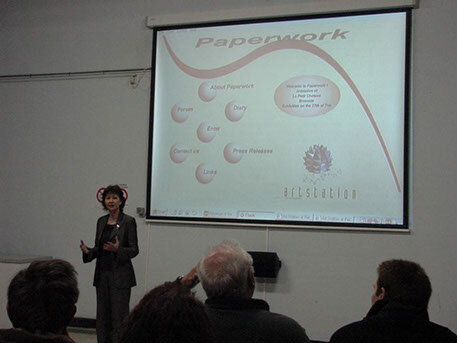Paperwork, 2001
The impossible jump for asylum seekers.
Having the right paperwork can save the life of a refugee or asylum seeker.
Paperwork suspends lives caught in the asylum seeker system.
Paperwork creates and maintains the potentials of the lives within the system.
Paperwork creates un-liveable and discontinuous lives.
Having paperwork can create new possibilities.
Systemic diagram of Paperwork
Paperwork examines lives suspended within Europe’s oldest and largest asylum reception centre. A short film had been made in Belgium and Wales by collaborating filmmaker, Wyn Mason and artist Glenn Davidson.
Wyn and Glenn had spent a week in Belgium in the Le Petit Chateau filming Paperwork. Le Petit Chateau the asylum reception centre was described as an echoing gloomy place of stone walls and floors, containing nothing to do for the residents. Video Documentation was shown of the asylum seekers in discussion with the asylum reception centre placement artists, which included French physicist Herve Gouget. We then saw Paperwork, a 10 minutes split screen film made with asylum seekers. Discussion moved to the metaphoric principle behind the use of paper, used to contrast the institutional effect on the lives of asylum seekers. This was how the adjacent film frames were used, an idea initially influenced by the ex annePeople Show performer and film maker Mike Figgis in his film “Timecode” made in 2000.
Paperwork Installation Film 2001.
Wyn was deeply affected as a student by the situation of the miners strike in 1984. He had started out as an art student but turned his back at the time after graduating in Exeter. His carer was then in television as an independent filmmaker producing drama and documentary for the BBC.
He later became disillusioned by the industry, mainly with the lack of control he had over the end product. Working with Glenn had given him a new chance to be more in control. Wyn had bought in to the collaboration many expectations from his experiences in the industry. His first encounter with Anne Hayes of Artstation produced heavy conflict. Whilst Wyn proposed scripted and pre-shot material Anne had stressed a very different approach, one that defined the work as what was not required! – it should not be drama, should not be documentary and should not be boring gallery or artist film (Wyn notes) but needed to engage with audience. In the eventuality of making Paperwork, the movie contained sequences of paper in flight over landscape, caught in a thorn tree and in ragged pieces, decomposing at the seashore. These were in fact pre-shot as Wyn was unable to resist preparatory work.
Wyn and Glenn had worked together in the past, they are quite different from each other. Glenn who works with Anne retain their fine artist identities. This produced a range of interesting differences which became evident in the making of the Paperwork.
Wyn’s use of meticulous planning in the creation of shooting scripts, rehearsals and general preparatory process behind drama and documentary making, he naturally expected to use within this new working context.
Glenn and Anne have been drawn into a very different course of action. Relying on knowledge they have built up over the last 29 years of working together, they are interested in freeing themselves of external assumptions and influences. Responding instead, in a raw and un-censored way to situations and locations in a real-time response. Glenn spoke of the need for artists to move away from the curatorial model toward more self initiated projects. He eulogised over the APG’s “open brief” model. He referenced Artstation’s partnership and background in Cybernetics described it as the Art and Science of knowing or a system for observing systems.
He introduced the Paperwork system diagram (top of page), showing the efficiency of the pictogram in systemic representation of the inputs, outputs and outcomes. Considerable Complexity of the project is conveyed in a singe image (see Agora pictogram above, created for the second phase of Paperwork), leading inexorably to the all encompassing nature of semantic images and representations. This was an introduction to Artstation’s pursuit of the single or core metaphor in their placements, it also shed light on how “suspension” emerged in the process of the placement and film.
Cardiff's Old Library Paperwork exhibition text introduced the film as follows :
Beneath, shining through the arch, a twin screen video installation. Video sequences cross the line between narrative (going somewhere) and composition and decompositions of paper (going no where). Images also contrast the rural and institutional. All actors in the video are asylum seekers and refugees suspended in European paperwork.
Paperwork will now be shown in its own right. The audience were finally asked to consider if the work stood on its own without the context of the installation and exhibition. The general feeling was that it could, but may appear somewhat abstract with no discernible narrative or dialogue. Further time would have been required to understand this more deeply.
We all departed to the art department for a glass of wine, joined by some of the remaining audience.
Artstation thank everyone who took part.
Paperwork exhibition Old library CAD design.


Asylum children at Le Petit Château, Brussels.

Paperwork visitors at exhibition Cardiff Old Library 2001




The team in Brussels at Le Petit Château Wyn, Herve and Glenn.


Paperwork expressing beyond help Herve with an asylum seeker from Congo at Le Petite Château, Brussels.

Paperwork created in dialogue at the asylum seeker reception centre Le Petit Château Brussels 38.

Paperwork work is taking its toll on the artists.

Asylum seeker from Tibet discussing the erasure of her language and cultural identity at Le Petit Château Brussels.
Paperwork - behind the scenes.
Commissioned by Cardiff 2008 as part of the European Capital of Culture bid for 2008.







